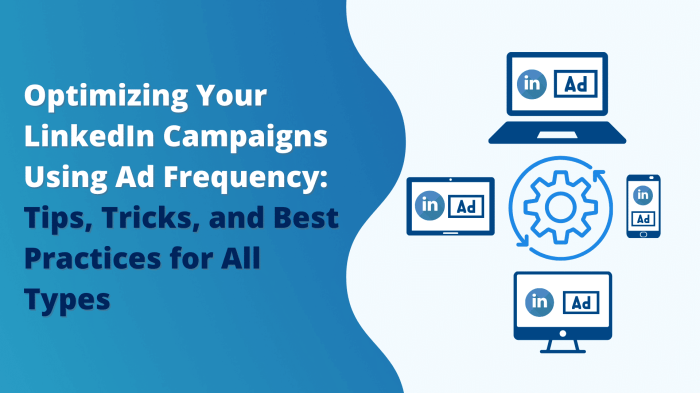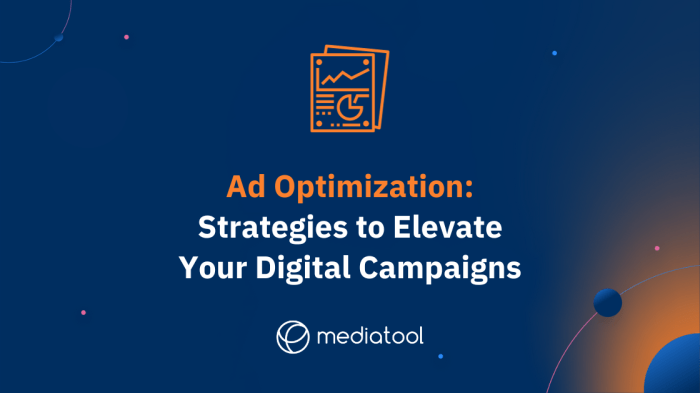Optimizing Ad Campaigns is the key to unlocking your marketing potential. Dive into the world of ad optimization and watch your campaigns soar to new heights.
From understanding the importance of optimization to analyzing key metrics and targeting the right audience, this guide has got you covered.
Understanding Ad Campaign Optimization

Ad campaign optimization is the process of refining and improving advertising campaigns to maximize their effectiveness and achieve better results. This involves analyzing data, testing different elements, and making adjustments to ensure that the campaign is reaching the right audience and delivering the desired outcomes.
Importance of Optimizing Ad Campaigns for Businesses
Optimizing ad campaigns is crucial for businesses to ensure that they are getting the most out of their advertising efforts. By continuously refining and improving campaigns, businesses can increase their return on investment, reach more potential customers, and ultimately drive more sales and revenue.
Examples of Successful Ad Campaigns that were Optimized Effectively, Optimizing Ad Campaigns
- The “Share a Coke” Campaign by Coca-Cola: Coca-Cola’s personalized “Share a Coke” campaign, where bottles were labeled with popular names, was a huge success. By analyzing customer data and optimizing their campaign to include a wide variety of names, Coca-Cola was able to significantly increase sales and engagement.
- Amazon’s Retargeting Campaigns: Amazon is known for its effective retargeting campaigns, where they show personalized ads to users based on their browsing and purchase history. By continuously optimizing these campaigns with relevant product recommendations, Amazon has seen a significant increase in conversions and sales.
Key Metrics for Ad Campaign Optimization

When it comes to optimizing ad campaigns, tracking the right metrics is crucial for measuring success and making necessary adjustments. By focusing on key metrics, advertisers can evaluate the performance of their campaigns and make data-driven decisions to improve results.
Click-Through Rate (CTR)
The click-through rate is a vital metric that shows the percentage of people who clicked on an ad after seeing it. A higher CTR indicates that the ad is resonating with the audience and attracting more clicks. By monitoring and optimizing the CTR, advertisers can improve the relevance and effectiveness of their ads.
Conversion Rate
The conversion rate measures the percentage of users who completed a desired action after clicking on an ad, such as making a purchase or signing up for a newsletter. A high conversion rate indicates that the ad is effectively driving actions from users. Advertisers can optimize the conversion rate by refining the ad messaging, targeting the right audience, and improving the user experience on the landing page.
Return on Ad Spend (ROAS)
ROAS is a critical metric that calculates the revenue generated for every dollar spent on advertising. By tracking ROAS, advertisers can determine the profitability of their ad campaigns and allocate budget more effectively. Adjusting targeting, ad creatives, and bidding strategies can help improve ROAS and maximize the return on investment.
Target Audience Analysis: Optimizing Ad Campaigns
Understanding the target audience is crucial in optimizing ad campaigns as it helps tailor the message to resonate with the right people, ultimately improving campaign performance.
Methods for Conducting Target Audience Analysis
- Utilize Analytics Tools: Use tools like Google Analytics to gather data on demographics, interests, and behavior of website visitors.
- Surveys and Feedback: Conduct surveys or gather feedback to understand the preferences and needs of the target audience.
- Social Media Insights: Analyze social media insights to gain insights into the demographics and behavior of followers.
- Competitor Analysis: Study competitors’ target audience and strategies to identify potential gaps or opportunities.
Tailoring Ad Campaigns to Specific Audience Segments
- Personalized Messaging: Customize ad copy and visuals to speak directly to the needs and interests of different audience segments.
- Segmentation: Divide the target audience into groups based on demographics, behavior, or interests, and create separate campaigns for each segment.
- A/B Testing: Test different ad creatives and messaging on different audience segments to determine what resonates best.
- Location Targeting: Use geotargeting to deliver ads to specific regions where the target audience is located.
A/B Testing Strategies
A/B testing is a method used in ad campaign optimization to compare two versions of a webpage or ad creative to determine which one performs better. It involves splitting the audience into two groups and showing each group a different version, then analyzing the results to see which version drives more conversions or engagement.
Best Practices for A/B Testing
- Clearly define your objectives: Before starting an A/B test, make sure you have a clear goal in mind, whether it’s increasing click-through rates, improving conversion rates, or boosting engagement.
- Test one element at a time: To accurately determine the impact of changes, focus on testing one variable at a time, such as headline text, images, or call-to-action buttons.
- Use a large enough sample size: Ensure that your test reaches statistical significance by using a sample size that is large enough to provide reliable results.
- Run tests simultaneously: To eliminate external factors that could skew results, run your A/B tests simultaneously rather than sequentially.
- Monitor and analyze results: Track key metrics during the test and analyze the results to determine which version performed better and why.
Analyzing A/B Test Results
- Identify the winning variation: Look at the data to determine which version of the ad or webpage produced the best results in terms of your objectives.
- Understand the why: Dive deeper into the data to understand why one variation performed better than the other. This insight can guide future optimization efforts.
- Implement changes based on results: Use the findings from your A/B tests to make informed decisions about how to optimize your ad campaigns for better performance.
